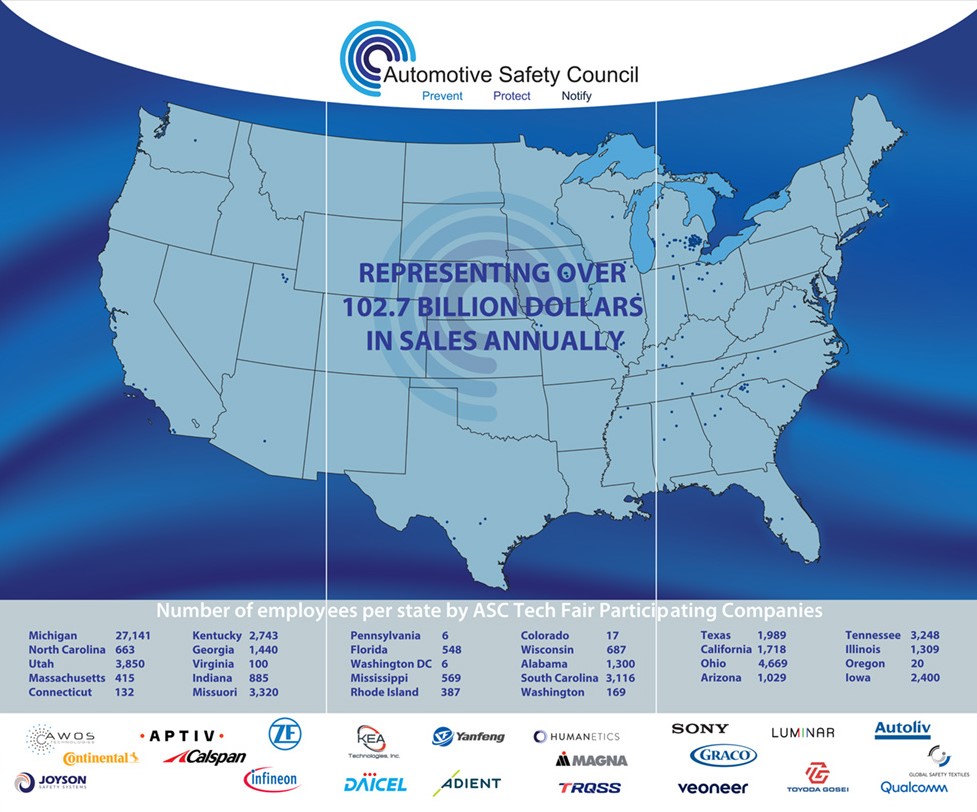
Washington DC ASC Safety Tech Show

Welcome to the Automotive Safety Council (ASC) Technology Presentation. The
ASC is the trade association of automotive safety suppliers whose mission is to
save lives and reduce injuries through the application of inventive safety
technologies. We hope you gain an understanding of current automotive safety
issues and solutions that are available now and in the future.
Presentation Slides (Sorted by Section)
Intro intro

Road User Crash Data 1
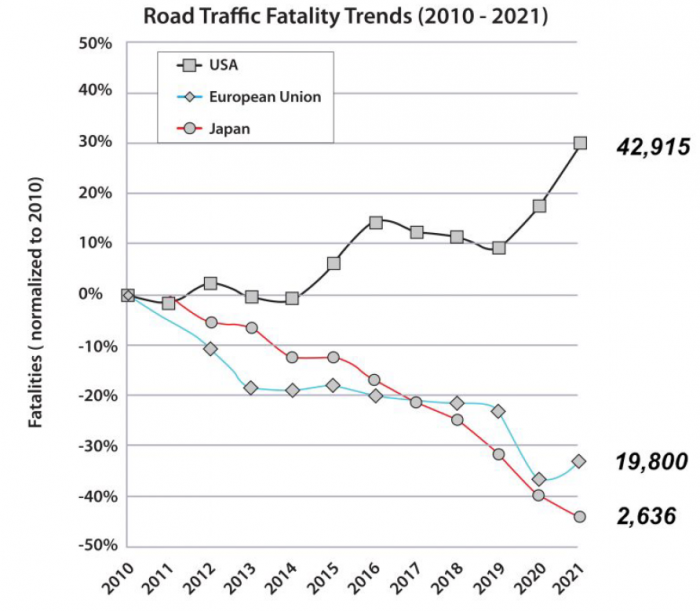
In the USA, road fatalities have increased more than 30% over the past 10 years for the following categories
- Vulnerable Road Users:
- Pedestrians + 70%
- Cyclists+ 59%
- Motorcyclists +35°/2
- Occupants of Vehicles:
- Passenger Cars & Light Trucks + 17%
- Large Trucks + 38%
- In Europe and Japan, road fatalities have dropped in all these categories over the same period
- In 2010 baseline road fatalities were 32,999 (USA), 29,611 (EU) and 4,691 (Japan)
Consumer Ratings Drive Change 2a
Safety is a perennial top consideration for consumers in making a new vehicle purchase
- Consumers rely on IIHS or US NCAP Star Ratings in making their safety decision
when purchasing a new car - Automakers advertise safety ratings to differentiate their vehicles
- Automakers safety content decisions are strongly influenced by ratings systems
- Rest of the world moving ahead with promoting crash avoidance technology
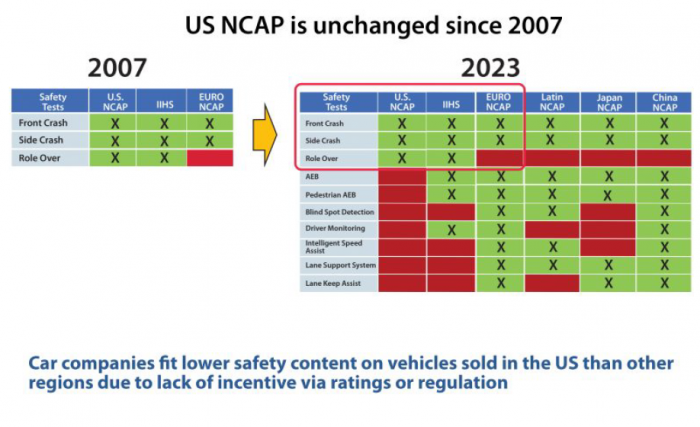
The National Traffic Safety Board (NTSB) has issued the following Most Wanted List for Safety Technology
- Eliminate Distracted Driving
- Implement a Comprehensive Strategy to Eliminate Speeding-Related Crashes
- Protect Vulnerable Road Users through a Safe Systems Approach
- Prevent Alcohol and Other Drug – Impaired Driving
- Require Collision Avoidance and Connected Vehicle Technologies on all Vehicles
Consumer Ratings Drive Change 3

Worldwide the star ratings through the New Car Assessment Program (NCAP) tests reflect how well a car performs
- Most change on a Tri-annual basis with published roadmaps for technology implementation and evaluation IHS
- Evaluation criteria for many vehicle safety attributes, including bonus/incentive points for certain content
- Automakers add content to obtain the highest rating and advertise their performance
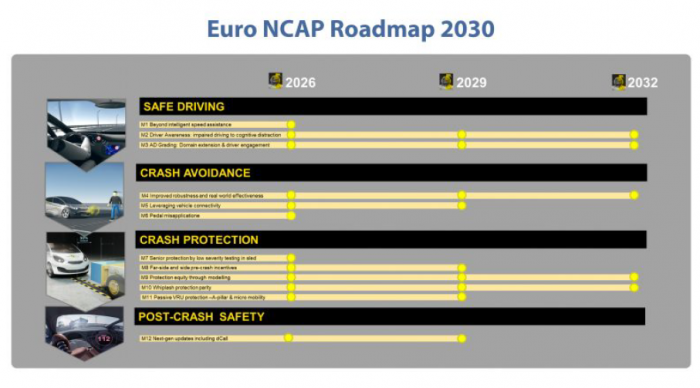
- Technology to improve US crash performance is already being used in many regions
- In the rest of the world, NCAP’s are tightly coupled with EURO NCAP test protocols
Equitable Occupant Safety 4

- Include advanced test devices that reflect women, men, and a range of body sizes equally
- Modernized test modes to reflect real-world crash types, vehicle size and weight, and driver line-of-sight
- Introduce tests that reward the integration of active and passive technologies for occupants and vulnerable road users to reduce real-world fatalities and injuries
Improving Traditional Passive Safety While Advancing Pre-Crash and Active Safety Technologies
Equitable Testing 6
WOMEN ARE MORE VULNERABLE TO INJURY THAN MEN AND SHOULD BE INCLUDED IN ALL SAFETY TESTING RATINGS
Tests should be applied equally across gender, age and size with more varied seating positions – the bias is toward male dummies

Women should be included in all US NCAP driver’s seat safety tests
More Advanced Testing Equipment 7
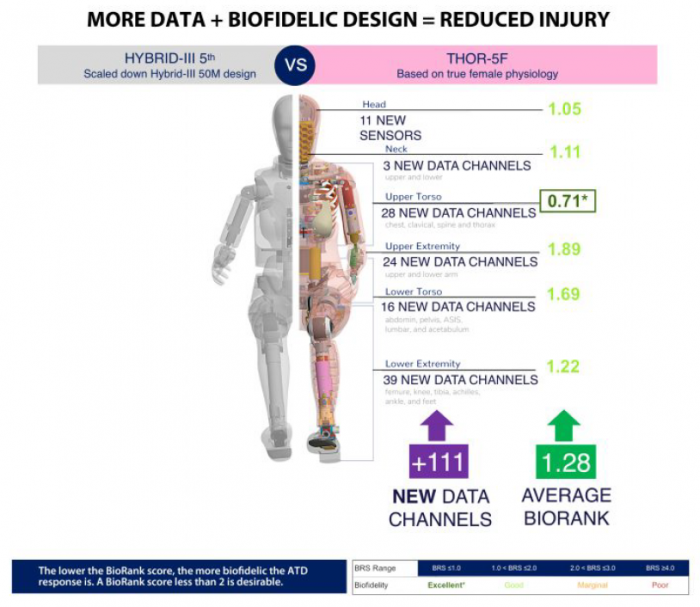
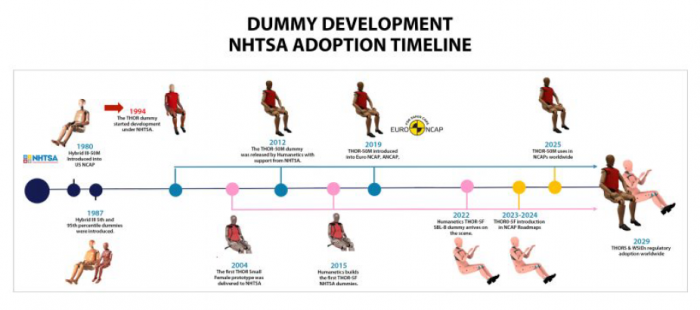
39% of Fatalities in Side Crashes 8
- 2015 NCAP proposed addition of the advanced biofidelic side impact dummy (WorldSID)
- To Date it has NOT been Implemented
- 2015 Euro NCAP Introduced WorldSID

Increased SUV, Pickup & Electrification Sales
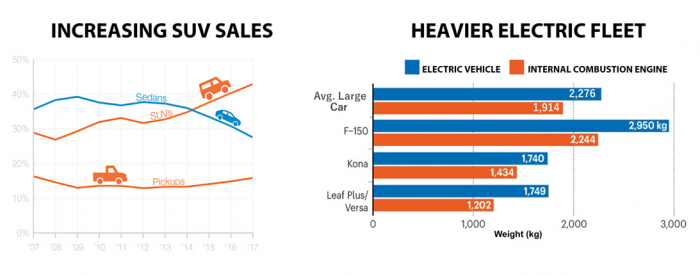
NHTSA MDB does not reflect actual vehicle weight in fleet
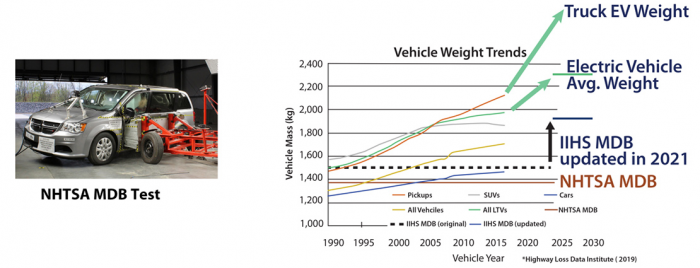
NCAP Side Impact Test has NOT been updated since 2009
Virtual Testing 10
Physical Testing Is Not Enough

- US NCAP only focuses on physical testing and has not implemented virtual testing
- Beginning 2024, Euro NCAP begins monitoring phase of scenario-based Virtual Testing-Assessment starts in 2026
- Drives robustness & real-world protection across increased number of scenarios
Both Virtual and Physical Testing Are Necessary
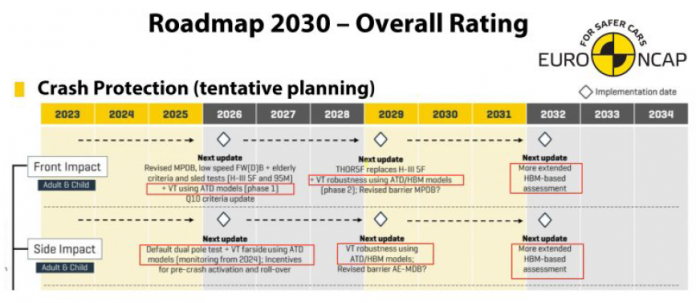
Adoption of virtual testing options by NHTSA could result in real world benefit of reducing fatalities on US roads
Human Body Model (HBM) 11
- Protection of car occupant is enabled by including HBMs:
- Remove hardware limitations
- Add diversity
- Improve real world benefit

- Different statures have different kinematics
- HBMs allow for a diverse representation of population
- Understanding crash speed and scenario variability as well as occupant variability is only feasible through virtual testing
Adoption of virtual testing with HBMs helps close any gaps in underrepresented segments of the population
Far Side Protection 12

- IIHS study showed 9% possible reduction of serious injuries in “Good” rated vehicles by implementation of Far Side protection
- Benefits: saving more than 3200 lives per year with estimated annual costs for far side fatalities :
- ~ $4,700,000,000

Most NCAPs globally have adopted far side protection NOT addressed in US NCAP
Driver Distration 13
- Distracted driving claimed 3, 142 lives in 2020, accounting for 8% of all crash fatalities
- Texting is the most alarming distraction. Sending or reading a text takes your eyes off the road for S seconds. At 55mph, that’s like driving the length of an entire football field with your eyes closed

Available driver warnings & monitoring technologies
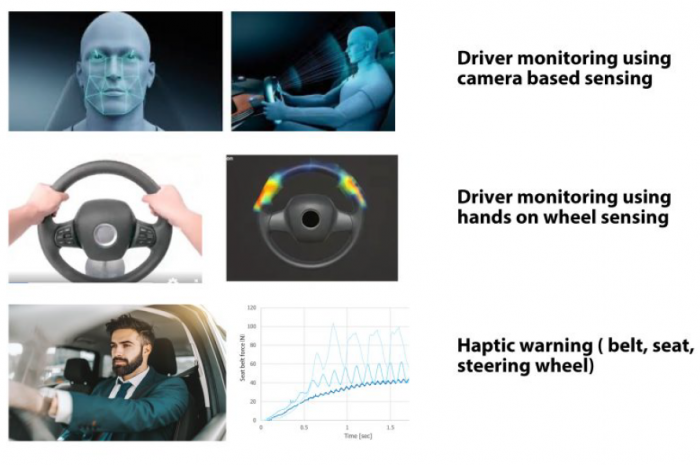
<5% market penetrations due to lack of inclusion in ratings
Alcohol Impaired Driving 14
- In 2021, 13,384 people were killed in motor vehicle crashes involving alcohol-impaired driving accounting for 31% of all traffic related deaths
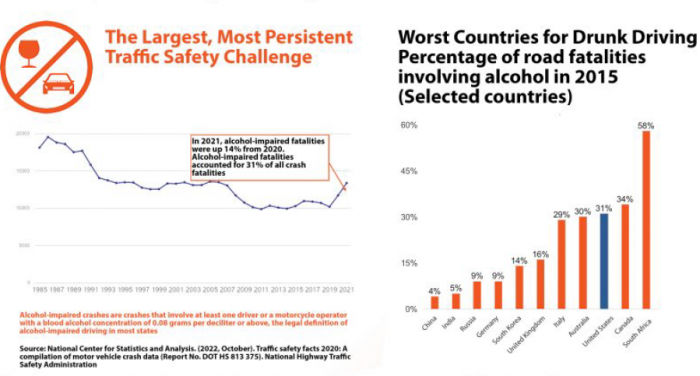
- Attempts to solve the problem through increased social education, law enforcement and legal consequences struggle to simply contain the problem
Implementation of driver impairment monitoring could potentially prevent 12,384 fatalities. This equates to a potential annual societal cost saving of $140 Billion (2019 dollars)
Source: Blincoe L, Miller T, Wang J-S, Swedler D, Coughlin T, Lawrence B, Guo F, Klauer S, Dingus T (2023). The economic and societal impact of motor vehicle crashes, 2018 (Revised) (Report No. DOT HS 813 403). National Highway Traffic Safety Administration.
Safety For New Occupant Positions 15
- Advances in ADAS and higher levels of autonomy will spur new interior layouts and position occupants out of the traditional (and tested for) seating position
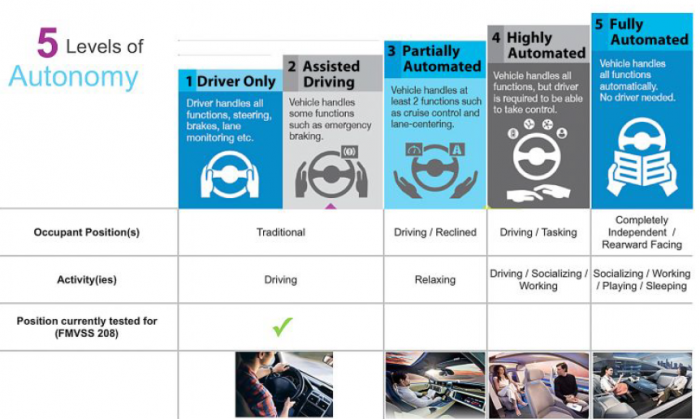
Technologies designed to protect for Non-Traditional Interior
- Research shows new non-traditional interior layouts, with flexible seating orientations, will require changes in technology to reduce the potential for injury
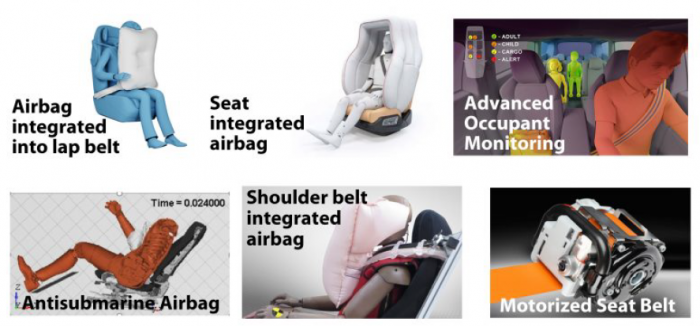
More Advanced Restraint Systems and Interior Sensing Technologies will be required to address the new interior layout seating for highly automated vehicles to mitigate injuries
AEB Influence On Occupant Position 16
- Cause and effect relationship between passive and active safety therefore it is important to activate all safety technologies in one test mode
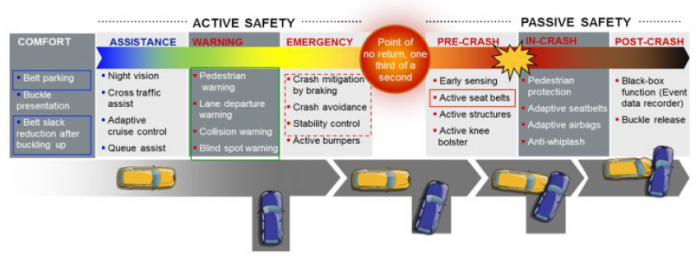
- Motorized Seat belt – Dynamic Testing in Test Car

Integrated Safety Solution
Rear Seat - Safety Regulations 17

The US has NO specific occupant injury criteria for rear seat occupants
- The rest of the world has test requirements for rear seat occupants
- There is a conflict between FMVSS 208 & 209 that does not allow for optimization of rear seat occupant protection with existing seat belt technologies
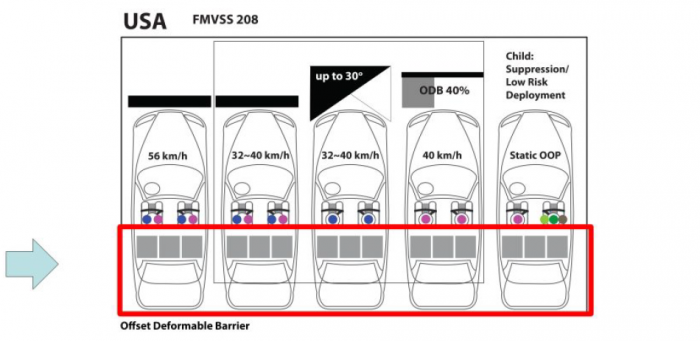
WHAT CAN BE DONE?

- Modify FMVSS 208 to include specific rear seat occupant injury criteria
- Modify FMVSS 209 to allow for load limiting technology
Aligning USA rear seat protection requirements with global norms would reduce fatalities and injuries
Rear Seat - Fatalities and Injuries Seated 18
- From 2010 to 2020 – 23,800 Rear Seated passengers killed and 2.5 Million injured Frontal impacts account for majority of fatalities, but rear impact causes most of the injuries
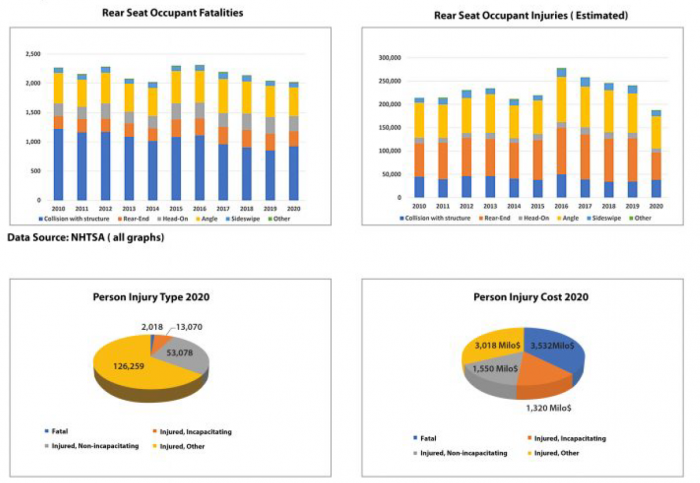
- In 2020 the Societal cost of killed and injured occupants was $16.3 Billion (direct economic costs)

- In 2020 10% of the rear seat passengers were unbuckled, but they accounted for more than 50% of the fatalities
Rear seat belt reminder regulation could result in a potential reduction of 30% to 50% (rates from peer countries) with up to 11,000 lives could be saved and 1.25 million injuries avoided over the next 10 years reducing the injury costs by approximatly $8 Billion
Rear Seat - Fatalities and Injuries 20
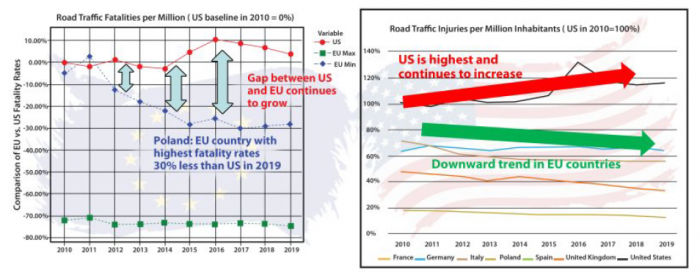
- US significantly behind European countries for fatalities and injuries
- EU has downward trend over last ten years, US has a slight upward trend
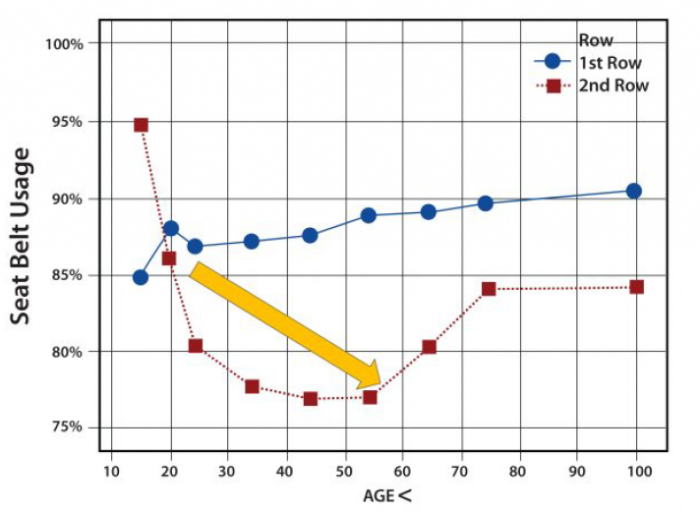
- Decreasing seat belt usage in 2nd row from adolescence until SO / 60 years old
- The 2nd row seat belt use rate is elevated by the frequency of children in child seats
There is a need for Rear Seat Belt Reminder regulation
Rear Seat - Belt Use Rates & Laws 21

- Children predominantly travel in rear seats
- Child seats provide best protection
- Older occupants have higher risk of injury / death
- Need front seat restraints technology in rear seat to protect older passengers
Data Source: IIHS / GHSA
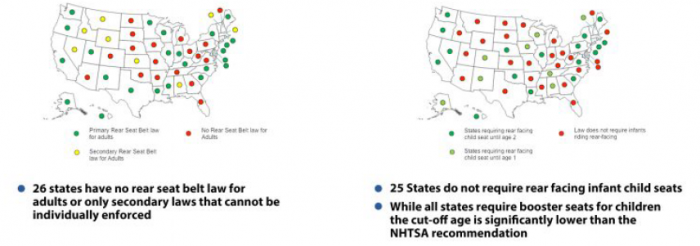
WHAT CAN BE DONE?
Make seat belt laws primary enforcement in all states and all seating positions
Rear Impact Regulations 22
- There are no FMVSS regulations or consumer ratings to assess occupant protection in higher speed rear impacts {>25km/h)
- Whiplash injury assessment is tested at much lower speeds and for front seats only
- Seat structure is only tested with a static test of the seat frame {FMVSS 207)
- Potential risk for front and rear seat occupant interaction at higher speeds
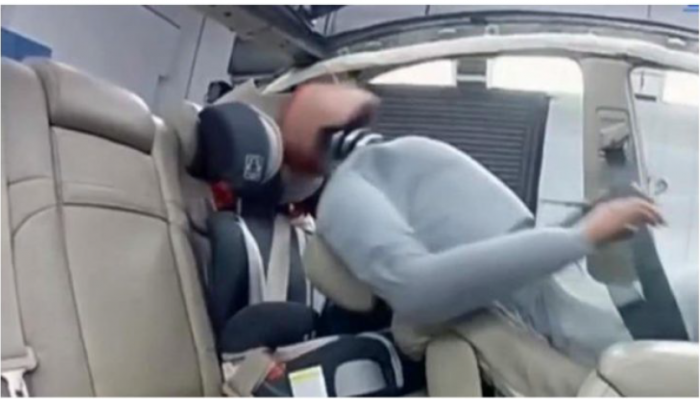
WHAT CAN BE DONE?
- Update FMVSS 207 to include industry best practices including dynamic back-frame displacement requirements
- Develop high-speed full vehicle Rear-End Crash test setup with dummy placement in front row and second row seats
- Define dummy injury assessment criteria for all occupants
.
Non Traffic - Child Fatalities 23

A car is like an oven
- A child’s temperature increases up to Sx faster than an adult
- Interior temperature can rise 20°F in 1 O minutes
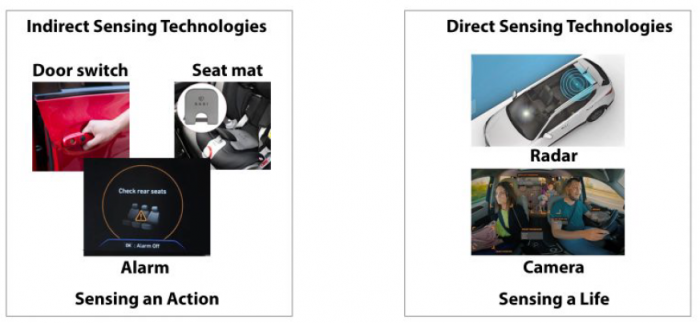
WHAT CAN BE DONE?
How countries are handling the problem:
- Italy has enacted a regulation
- Europe & Asia has mandated via NCAP Direct Sensing Technologies Camera Sensing a Life
- US is only addressing this via an information campaign for the future
Child Seat Safety 24
Reducing Rotation during an Accident in Rear Facing
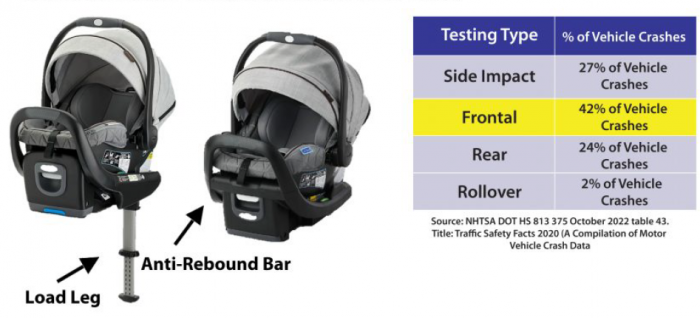
Rear-Facing Car Seat Usage
- The American Academy of Pediatrics recommends children ride rear-facing until at least 2 years of age
- Rear-facing helps keep children up to Sx safer
- Rear facing seats help support the head, neck, and spine in the event of a motor vehicle collision
- Load Leg Technology
- Provides an extra layer of rear-facing protection for infants 4-35 lb. and up to 32″ tall. In the event of an impact the load leg helps transfer car seat energy to the vehicle floor to reduce rotation and add stability
- Anti-Rebound Bar
- Provides an additional layer of rear-facing safety by limiting rotation of the seat and your child in the event of an impact
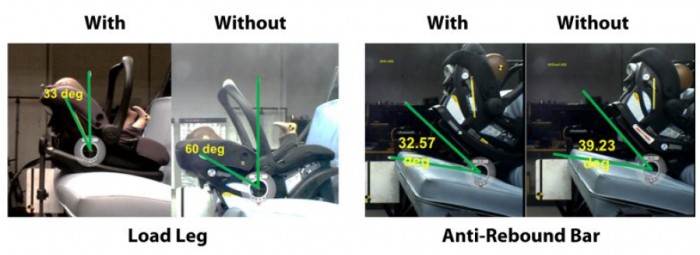
Rear Seat Performance - IIHS 25
- IIHS has released a new protocol for rating rear occupant performance in frontal crashes
- Similar to NCAP from other regions, the new test adds a dummy (representing a small female or 12-year-old child positioned) in the second row behind the driver
- New metrics focus on the injuries most frequently seen in rear-seat occupants
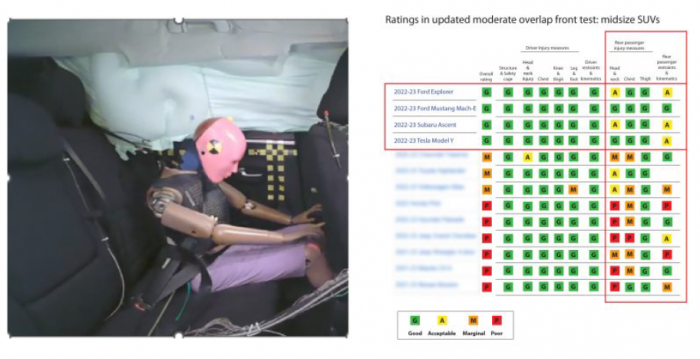
- All of the above tested vehicles achieve a good rating for front seat
- Only 4 of 13 vehicles recently rated earned a good rating for rear occupant protection
- This rating will highlight the improvement potential of advanced seat belts and seat design
- Modify FMVSS 208 and 209 to allow occupant safety improvements and ensure component integrity
Rear Seat - Inflatable Restraints 26
- Rear-seat passengers are at higher risk of injury than front-seat occupants
- Chest injuries are the most common serious rear-seat injuries for adults Per IIHS the risk of a fatality is 46% higher for belted occupants in the rear seat than in the front seat because the front seats are equipped with airbags and advanced seat belts
IIHS introduced in 2022 a new rear seat protection protocol following EuroNCAP, ChinaNCAP, KoreaNCAP and JapanNCAP
- Inclusion of inflatable restraints and advanced seat belts on rear seats would reduce fatalities and risk of injuries
- Various rear seat inflatable restraints to further enhance all rear seat occupants’ protection are available
- Lack of regulations and consumer ratings limit mass production and implementation in all vehicles
Occupant Monitoring Systems 27
- Advance interior monitoring will enhance proper seat belt usage detection combined with seatbelt reminders to provide adaptive restraint systems in case of a crash
- 3D advance sensing to:
- Improve occupant classification and detection for current and future in-position and out-of-position FMVSS requirements
- Supports driver monitoring systems for greater reliability in case of distraction or drowsiness
- IIHS requires safeguarding to know where the hands are during automated driving level 2+ for readiness to take over driving function when required
Technologies designed to improve occupant sensing

3D advance sensing can help improve occupant classification and detection (size, posture, position) and weight when combined with other vehicle integrated sensors
Future Automotive Seating Concepts 28
- Increased comfort and functionality on all seat rows
- Captains chair rather than bench solutions
- Front seats identical to rear seats
- Increased adjustability fore/aft and deep recline
- All safety features to be integrated in the seat
- Meet safety requirements in all seating positions or move occupant into an upright position if a crash is imminent
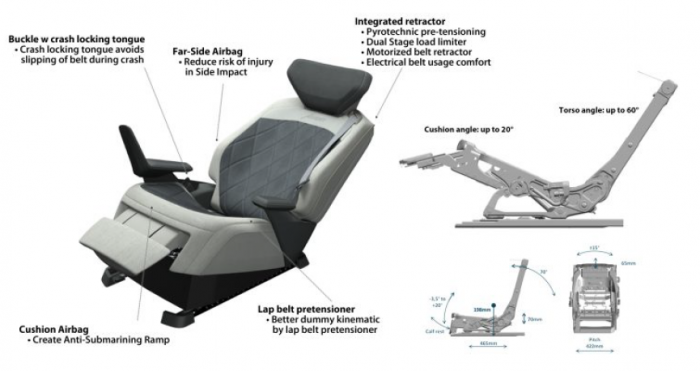

More advanced restraint systems and interior sensing technologies will be required to address the new interior layout seating
·
Real World Crash Types 29
- The Economic cost of motor vehicle crashes that occurred in 2019 totaled $339.8 Billion
- Equates to $1,035 for every person living in the United States
- 1.6% of the U.S. GDP
- NHTSA has identified five (S) groups of crash avoidance technology (ADAS) that addresses nearly 62% of all crashes
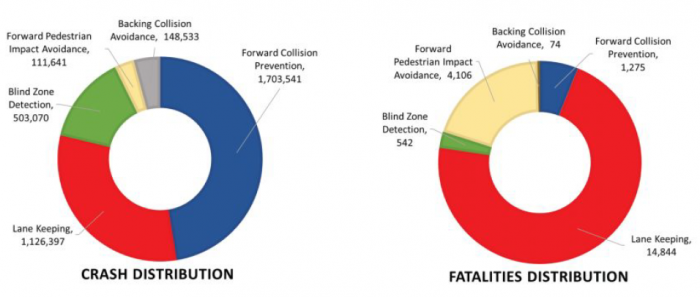
The Insurance Institute for Highway Safety studies shows the real-world effectiveness of these technologies
Forward Collision Warning plus Autobrake Systems
- Reduced front to rear crashes by 56%
Lane Departure Warning
- Reduced sideswipe and head on crashes by 11 %
- Reduced injury crashes by 21%
Blind Spot Detection
- Reduced lane change crashes with injuries by 23%
Rear Automatic Braking
- Reduced backing crashes by 62%
Rear Cross Traffic Alert
- Reduced backing crashes by 22%
US Driver Assistance Today 30
- The AEB voluntary commitment, signed by 20 OEMs selling passenger vehicles in the U.S., has made front AEB virtually standard since September 1, 2022
- Performance requirements are low, and equate to those required to meet EU NCAP 10 years ago
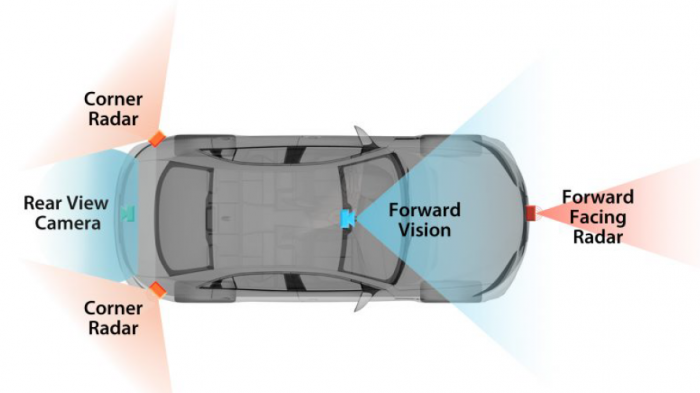
- The availability of Active Safety technologies, known as Advanced Driver Assistance Systems (ADAS) varies by vehicle OEM and models
- Typical ADAS content on vehicles sold in the US:
- Backup Camera – required since 2018
- Forward Collision Warning (FCW)*
- Automatic Emergency Braking (AEB)*
- Pedestrian AEB
- Blind Sport Warning (BSW)
- Lane Departure Warning (LDW)* / Lane Keeping Assist (LKAS)
- Rear Automatic Braking
We can do better; a revised US NCAP/FMVSS update with more stringent requirements would help improve safety
*Included in the infrastructure investment and jobs act (2021 )/ Recommended by NHTSA
Automatic Emergency Braking 31
Passenger Vehicles AEB
- Automatic Emergency Braking (AEB) uses sensors to track vehicles ahead, provides audio, visual, or haptic warnings of possible collision and automatically applies brakes in an impending crash
- AEB is effectively a standard based upon the Voluntary Commitment signed by 20 OEMs
- Higher AEB standards via NCAP would enhance safety performance A NHTSA NPRM to require vehicle AEB on light vehicles is pending; currently at 0MB for review
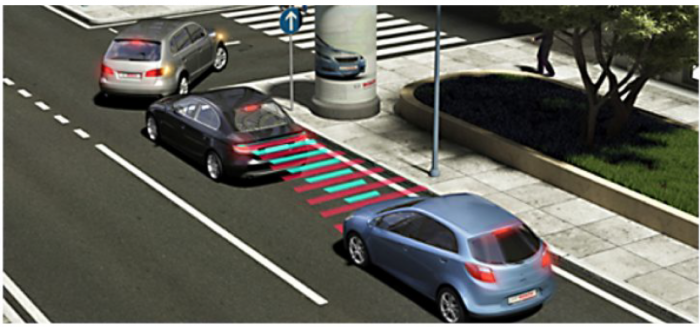
Commercial Truck AEB
- Truck AEBs with multiple sensors can mitigate/ avoid collisions with:
- Vulnerable road users
- Vehicles in lane, with traffic in multiple lanes and during AEB events with lane changes (Multi Braking Events)
- Roadway departure is a frequent cause of truck rollovers or cross median crashes
- Roadway departure braking is a special AEB feature that can prevent these kind of collisions
- AEB mandated in Europe since 2013 for trucks over 3.5 tons
- Heavy-Vehicle AEB rule is under review by 0MB (April 2023)
ADAS Safety Systems 32
AEB for light and commercial vehicles
Lane Departure Prevention
Lateral Safety Systems 33
Lane Departure Prevention (LOP)
Front camera used to detect lane markings and identify when the vehicle unintentionally leaves its lane
- Lane Departure Warning provides audio, visual and/ or haptic (e.g. vibration) alerts to the driver
- Lane Keeping Assist and Lane Centering use the vehicle steering system to help the driver stay safely in the lane

Blind Spot Detection (BSD)
Uses side/rear-facing radars or cameras to detect vehicles in adjacent lanes that the driver may not see, to reduce side-swipe collisions
- Audio, visual or haptic alerts help the driver to change lanes safely
- Can also include active Lane Keeping Support via vehicle steering system

If standard, lateral safety systems could reduce the ~18,200 deaths (51 %) that occurred in the USA in 2020 following roadway or lane departures. This equates to a potential annual societal cost saving of up to $175 Billion
Vehicle Submersion 34

- 500 people in the US drown every year due to vehicle entrapment
- Only one minute to escape a car filling with water
- Vehicles can sink in natural disasters like flash floods and sinkholes or falling/driving into deep water or lakes
- Modern features can trap people & impede rescue:
- Automatic door (un)locking systems
- Electronics that can fail in water
- Shatterproof side windows render manual tools obsolete
- Euro NCAP and ANCAP introduce new submersion protocols (Jan 2023) due to occupant entrapment and rescue challenges

Automated System for Opening Windows
- Research shows rapid self-rescue is essential for survival in a submersion
- An automated system for opening windows allows occupants to quickly & safely exit
- Reliable & rapid submersion detection
- Lowers all side windows automatically
- Real-time notification to facilitate rescue
If standard, auto window opening systems for submersion events could save up to 500 lives annually, providing an annual societal cost saving of up to $4.8 Billin
Battery Safety for EVs 35
Background
- The increase in electric vehicles (EV) is introducing new & unique safety challenges (30% EV market share by 2030)
- In the event of an emergency the vehicle occupants, rescue personal and bystanders must be protected from electrical hazards & fires (FMVSS 305)


Solution
- Pyrotechnic battery disconnect devices have been developed utilizing technology proven in airbags and seat belts
- Pyrotechnic solutions are exceeding capabilities of traditional fuses & relays
- They are fast and reliable, operating in milliseconds (~2ms) and at extreme energies
Vulnerable Road User (VRU) Crash Data 36
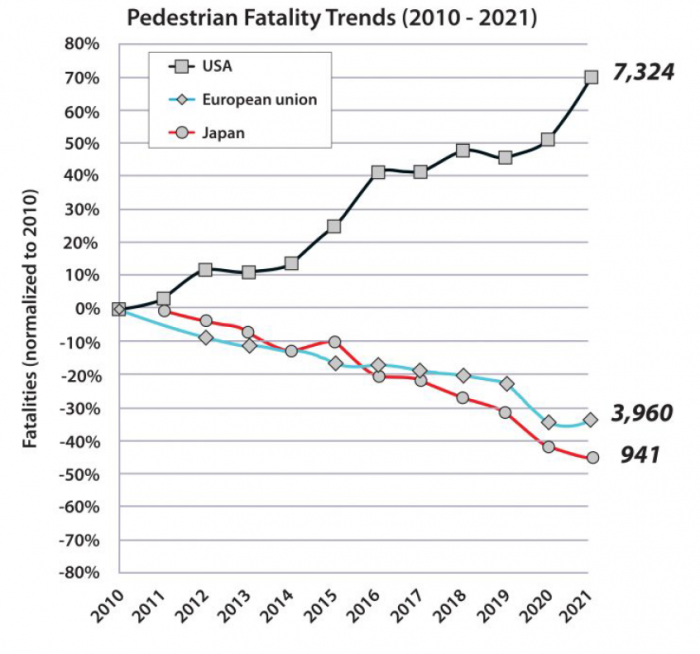
- In the USA, fatalities involving Vulnerable Road Users {VRUs) outside vehicles have increased over the past 10 year
- Pedestrians+ 70% (shown above)
- Cyclists + 59%
- Motorcyclists +35%
- In Europe and Japan, fatalities involving VRUs have dropped in all categories over this period
- In 2010 baseline pedestrian fatalities were 4,302 (USA), 5,952 (EU) and 1,709 (Japan)
Real World VRU Crash Types 37
- Vulnerable Road User crashes account for 33% of all motor vehicle related fatalities. VRUs contribute to nearly all crash types, and ADAS technology has been identified as potential solution by NHTSA and NTSB to address this issue
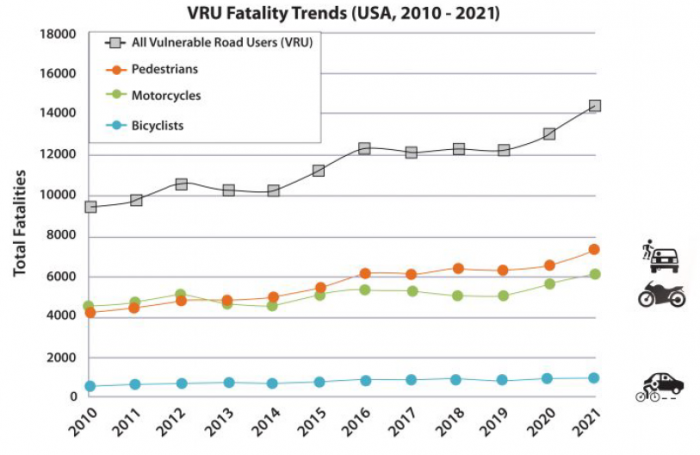
- Pedestrian fatalities account for 17% of motor vehicle fatalities
- The following scenarios account for more than 90% of the pedestrian fatalities and can be addressed by Advanced Driver Assistance Systems (ADAS) currently available on the market

80% of pedestrian fatalities occur in dark conditions
US VRU Driver Assistance Today 38
- Automatic Emergency Braking Voluntary Commitment performance requirements are relatively low, and similar to those required to meet EU NCAP 10 years ago
- Current systems are not optimized for VRU detection and protection
- Pedestrians
- Cyclists
- Intersections
- Low light/fog
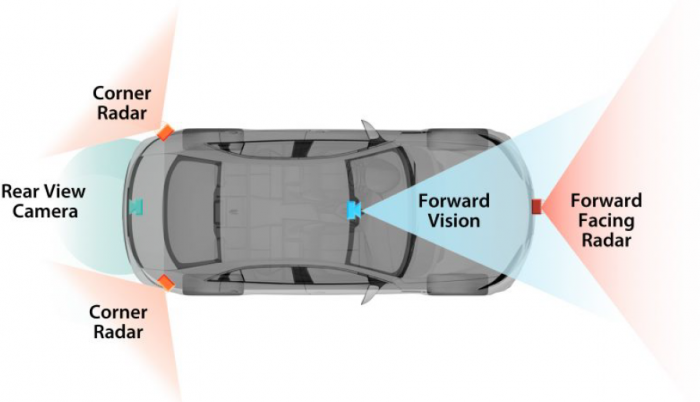

- Technology exists to improve effectiveness
- EU and Japan NCAPs are driving advanced technology that could benefit US VRU safety
- New IIHS Top Safety Pick+ requirements for 2023 now encourage fitment of higher performance VRU AEB systems including at night
- A NHTSA NPRM to require pedestrian AEB on light vehicles is pending; currently at OMB for review
High Performance ADAS Sensors 39

Front Safety Cameras
- Take high resolution pictures
- Very good at measuring angles and recognizing objects
- Not as accurate at measuring distances and speeds as radar and LiDAR sensors
US Standard View Cameras
- ~1 MP imager, 50° field-of-view
Compromising between high-speed highway driving and low-speed city driving - Some limitations in detecting crossing vehicles and pedestrians at short range
in city environment
Wide View Cameras
- Common in Europe today
- Higher resolution imager chips (2-8MP) and wider view lenses (up to 100°) to improve detection of crossing vehicles and pedestrians for urban driving
- Also helps when turning at intersections to see crossing pedestrians or
parked vehicles earlier
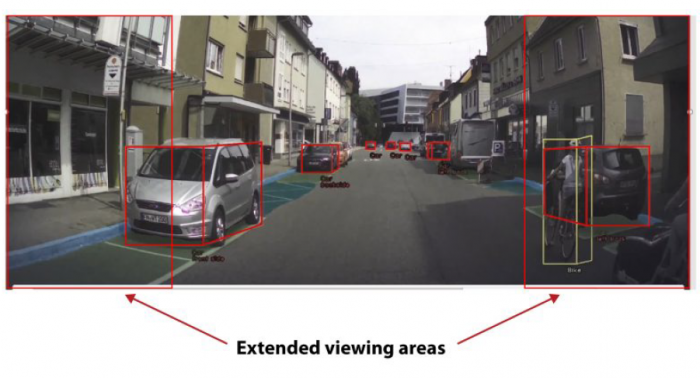
High Performance ADAS Sensors 40
Wide view camera videos / animations
Imaging radar, LiDAR videos / animations
High Performance ADAS Snesors 41

Digital Imaging Radar
- Digital imaging radars are higher resolution than standard ADAS radars, and can provide better
Automated Driving performance - Very accurate for measuring speeds and distances Less affected by rain or snow than optical sensors




LiDAR
- Uses laser beams to scan the environment around a vehicle, and can provide high-resolution
3D images, even at night - Even more accurate than radar for measuring speeds and distances
- LiDAR is also effective in detecting lane markings

V2X Sensor Data Sharing 42
Motivation
- Nearly half of crashes with other vehicles or Vulnerable Road Users (VRUs) cannot be avoided solely with “Line-of-Sight” (LOS) sensors
- Over 7,000 pedestrians deaths per year in the US
Sensor Data Sharing Message (SDSM)
- Vehicle-to-everything (V2X) systems use short range radio communication between vehicles to exchange road safety information
- A new, V2X message has been standardized (in US, Europe, and a version in China) to address these Non-Line-of-Sight (NLOS) crashes
- Along with ADAS and basic V2X, SDSM can help to address up to 90% of all vehicle-versus-VRU crashes
- Also helps to protect against collisions with unconnected (non-V2X) vehicles
- Provides increased benefits compared with just ADAS and basic V2X
If standard, V2X could reduce the number of vehicle-to-vehicle crashes by up to 80% and the number of vehicle-to-VRU crashes by up to 90%
43
- Annually 7,324 pedestrians are killed and an estimated 356,141 injured
- Technology to help protect pedestrian and cyclists by reducing head injuries up to 40%
- Pedestrian Hood Lifters (PHL) create space between the engine/hood to prevent head contact with the engine
- Pedestrian DProtection Airbags (PPA) cushion head impact with windshield and roof pillars
- US has unique challenge due to vehicle fleet: pickups and large SUVS
- External airbags

- 11 million vehicles will be produced with PHL and 220k PPA around the globe in 2025. None in the US
- US OEMS are installing PHLs in their vehicles for exports to global markets driving this installation through regulations
On May 22, 2023, NHTSA issued a Request For Comment (RFC) to upgrade the USNCAP for Pedestrian Protection. The RFC incorporates elements of existing Euro NCAP Pedestrian Protection requirements
Improved pedestrian protection could have reduced the ~7,324 pedestrian deaths by 80% in the USA in 2020, saving ~5900 lives. This equates to a potential annual societal cost saving of up to $57 Billing
Low Speed AEB for VRUs 44
- FMVSS111 Rear Visibility requires rearview image display directly behind the vehicle since May 2018. However, the driver must actively watch the screen to check for pedestrians

- Low Speed Front- and Rear Automatic Emergency Braking systems detect objects close to the vehicle that are difficult for drivers to see due to blind spots
- Alerts the driver and automatically brakes if necessary to mitigate or avoid a collision

If standard, active low speed braking systems could reduce the ~ 780 non-occupant deaths (10%) in the USA in 2020 that occurred in non-traffic crashes. This equates to a potential annual societal cost saving of up to $7 .S Billion
VRU Safety at Night 45
Advanced Lighting Systems
- Auto High-Beam functions can turn on high-beams automatically when there are no vehicles nearby, significantly improving driver and camera visibility (drivers only manually use high-beams about 25% of the time)
- Adaptive beam lighting systems (e.g. LED matrix lights) can improve driver and camera visibility even when other vehicles are nearby, by turning off lighting segments that could distract other drivers
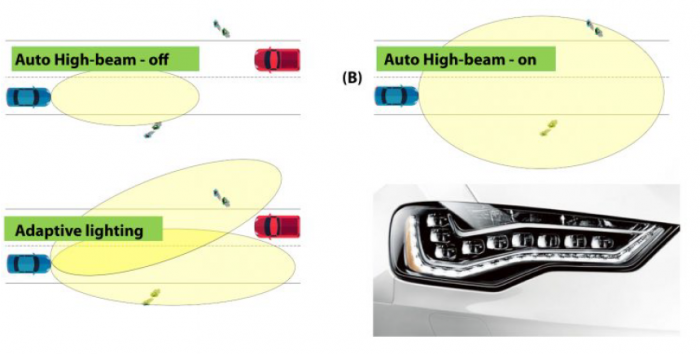
Advanced Sensor Technologies
- Radar and Lidar sensors are not affected by ambient light levels – they work as well at night as in daylight, and can can detect pedestrians more than 200m ahead of the vehicle
- 3 in 4 US pedestrian fatalities occur at non-intersections on roads, and almost 1 in 5 is on rural roads (NHTSA 2020)
- Advanced sensors can warn drivers earlier of pedestrians presence, so they can maneuver
accordingly - Advanced sensors can also protect VRUs in crossing and other complex scenarios
If adaptive lighting were standard, improved ADAS sensor performance at night could reduce the ~5,200 pedestrian deaths (80%) in the USA in 2020 that occurred in darkness. This equates to a potential annual societal cost saving of up to $50 Billion
Technology for Higher Autonomy 46
Today’s ADAS technology provides the building blocks for higher levels of automated driving
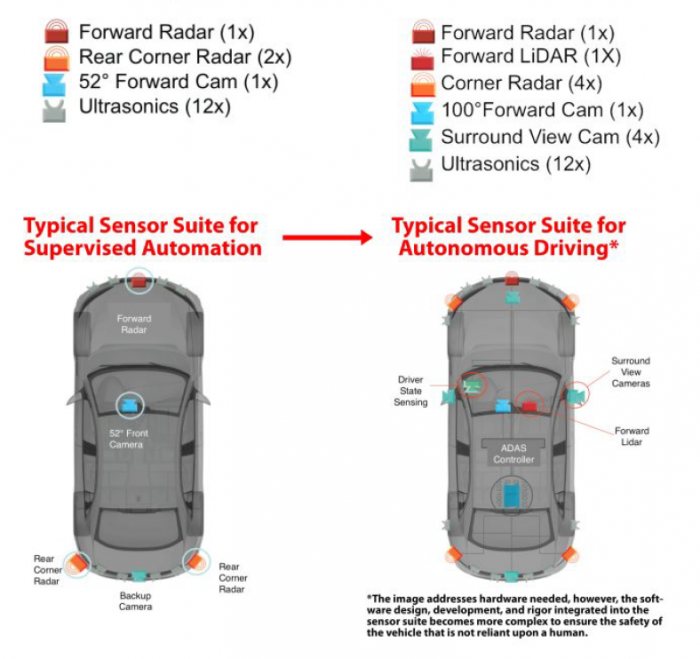
ADAS systems reduce crashes, crash severity, injuries, and fatalities
- Government incentives to increase ADAS deployment will yield more safety benefits and drive down cost
- Globally, other NCAP performance requirements are more advanced than the US and are driving enhanced system performance
Let’s put the U.S. back in the lead by promoting:- Full 360° sensor coverage including interior sensing for driver state
- Wider sensor field-of-view (FOV)
- Enhanced vision and radar sensor resolution
- Addition of LiDAR providing triple redundancy
- Machine learning to extract more information from the sensors and fusion of data from all sensor types
- Autonomous vehicles will contain more sensors, providing enhanced coverage and redundancies, along with more complex software
